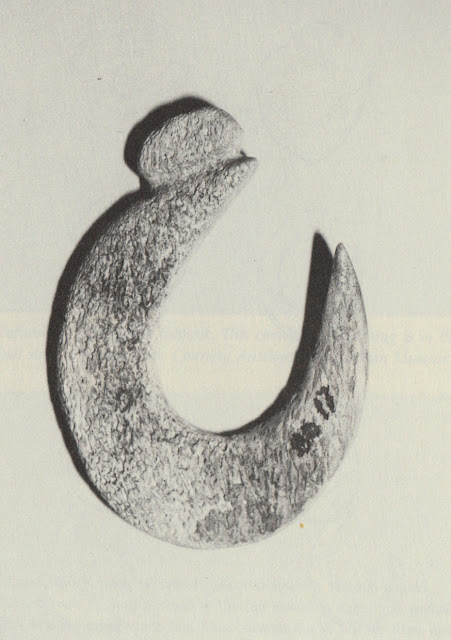I'm currently doing some research for an upcoming series of articles for the
Fullerton Observer Newspaper about the original inhabitants of Los Angeles and Orange County: The Kizh tribe. They are sometimes also called Gabrielenos, Gabrielinos, or Tongva. But I have
met and spoken with the current living chief of the tribe, Ernie Salas, and he assures me that they are called the Kizh, so that is the name I'll use, out of respect.
I recently finished reading a book called
The Gabrielino by Bruce Miller. The more I research this tribe, the more I realize that the task of re-constructing the real history of these people is difficult. Accounts differ, and many of the histories that exist have been published by amateur historians. The only book that is actually written by tribal members is a slender but fascinating volume called
Toypurina: The Joan of Arc of California.
The best feature of Bruce Miller's book is that it features a wealth of photographs of artifacts from Kizh culture. It should be noted that some of these objects may actually come from their neighboring tribe to the north, the Chumash, with whom the Kizh traded regularly. With that caveat, however, I'd like to share some of the images from Miller's book, as they give visual evidence of some important aspects of daily life of these local native people, and what life was like before Europeans arrived in Southern California.
Basketry
 |
| Wooden fiber bag or purse from San Nicolas Island. Courtesy Antelope Valley Indian Museum. |
 |
| Basket hopper mortar. Courtesy Southwest Museum. |
 |
| Wicker seed beater. Photography by Bruce Miller. Courtesy Southwest Museum. |
Wood and Stone Tools
 |
| Small sandstone mortar and pestle. Photography by Bruce W. Miller. Courtesy Antelope Valley Indian Museum. |
 |
| Steatite Cup. Courtesy Antelope Valley Indian Museum. |
 |
| Sandstone cup. Courtesy Antelope Valley Indian Museum |
 |
| Steatite paint mortar and pestle. Courtesy Antelope Valley Indian Museum. |
 |
| Small Serpentine finger bowl possibly for ritual use. Courtesy Antelope Valley Indian Museum. |
Effigies (animal figurines with spiritual significance)
 |
| Steatite killer whale effigy found on the Rindle Estate, LA County. Courtesy Southwest Museum. |
 |
| Seatite charms from Catalina Island and other sites. Courtesy Southwest Museum. |
 |
| Swordfish effigy. Photograph Bruce W. Miller. Courtesy Los Angeles County Natural History Museum. |
 |
| Steatite charms and fetishes from Southern California. Courtesy Southwest Museum. |
Hunting
 |
| Stone knife with a wooden handle--Seal Beach, CA. Note shell bead inlay. Courtesy Southwest Museum. |
 |
| Chert and obsidian arrow points form Malaga Cove, site of prominent Kizh village Chowigna. |
Fishing
 |
| Unfinished abalone shell fishhook. Courtesy Antelope Valley Indian Museum. |
 |
| Two finished abalone shell fishhooks. Antelope Valley Indian Museum. |
 |
| Large fishhook, perhaps for ceremonial purposes. Antelope Valley Indian Museum. |
Food/Cooking
 |
| Steatite cooking bowl. Courtesy San Luis Obispo Historical Museum. |
 |
| Incised steatite bowl. Courtesy Southwest Museum. |
Clothing
 |
| Woven grass skirt. Courtesy Antelope Valley Indian Museum. |
 |
| Bone awl or hair ornament. Decorated with olivella shell beads. Southwest Museum. |
 |
| Carved bone hairpins, some with decorative shell beads. Antelope Valley Indian Museum. |
 |
| Steatite finger rings. Antelope Valley Indian Museum. |
 |
| Perforated steatite pendants from Catalina Museum. |
 |
| Incised sandstone pendant. Antelope Valley Indian Museum. |
 |
| Olivella shell bead necklace with steatite pendant strung on rawhide. |
 |
| Olivella shell bead necklace with sandstone pendant. Antelope Valley Indian Museum. |
 |
| Shell artifacts from Catalina Island: bracelet, sand dollar pendant, ring. |
Shelter
 |
| Thatched Kizh domicile. Photo by Bruce W. Miller. LA County Natural History Museum. |
Trade
 |
| Shell bead money. Note relative uniformity. Antelope Valley Indian Museum. |
Art
 |
| Kizh rock painting. Southwest Museum. |
 |
| Rock painting attributed to both Chumash and Kizh/Gabrieleno. Southwest Museum. |
Shamans
 |
| Steatite pipes. Used for pleasure and by shamans. Photo Bruce Miller. Antelope Valley Indian Museum. |
 |
| Charmstones. Used by shamans to predict the future and change the weather. |
Music
 |
| Bone whistles. Courtesy collection of J.A. Barro and Southwest Museum. |
 |
| Deer tibia whistles from San Nicolas Island. Southwest Museum. |
Finally, lest we forget that this is a living, still-existing tribe, here I am with Chief Ernie and his daughter Nadine Salas a few years ago...

To learn more about the Kizh tribe, visit their web site
HERE.





































